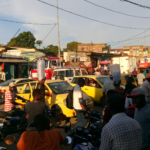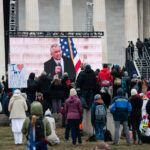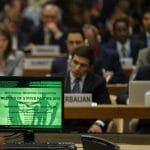Teaching biosecurity
By Malcolm Dando | December 2, 2010
In his keynote address delivered at the International Conference on Science and International Security: Addressing the Challenges of WMD Proliferation and Terrorism in Madrid on November 9, Sen. Richard Lugar, Republican of Indiana, stressed the need to expand the 20-year-old Nunn-Lugar Cooperative Threat Reduction (CTR) Program, which he and former Sen. Sam Nunn, Democrat of Georgia, developed in 1991 to secure and destroy nuclear, chemical, and biological weapons in the former Soviet Union.
When Senator Lugar set off from Madrid to Kenya and Uganda to take Nunn-Lugar to Africa, I hope he saw beyond the broken windows and simple padlock security gaps and recognized the need for a serious concentration on biosecurity education worldwide.
Lugar argued that while the CTR has mainly focussed on decommissioning or stockpiling old Soviet nuclear weapons, it now must expand to deal with the growing biological threat, and do so throughout the world. “As we look to the future of the Nunn-Lugar program, biological threat reduction is an area that is rapidly increasing in importance. The work of securing dangerous pathogens, building central reference laboratories, and establishing disease surveillance and monitoring is critically needed in many parts of the world,” he said. In his view “the global Nunn-Lugar program can become the epicenter of US non-proliferation and counter-proliferation efforts.”
While Lugar thought that the experience of the Nunn-Lugar program will be of help, he did not underestimate the challenge posed by the differences between the biological and nuclear threats. As David Franz, a leading biological weapons expert and chief inspector on three United Nations Special Commission biological warfare inspection missions to Iraq, and colleagues noted in a paper in Biosecurity and Bioterrorism last year, the nuclear threat “involves rare materials and costly, complicated science and is practically restricted to nation states; [biological weapons] involves agents that can be inexpensively and readily obtained and science not restricted to nation states …”
Yet there are other differences between the nuclear and the biological problem that are not so obvious. One such difference concerns the low level of awareness of the dual-use problem among life scientists. This could frustrate well-intentioned efforts to improve biological security, but steps can be taken to deal with the problem if State Parties to the Biological and Toxins Weapons Convention (BTWC) take concerted action next year at the Seventh BTWC Review Conference in December.
In its Article IV, the BTWC requires that parties closely follow the Convention and “take any necessary measures to prohibit and prevent” the dual-use of biological materials. The use of the word “prevent” makes it clear that states’ obligations go well beyond just passing a law. This became obvious at the Second BTWC Review Conference in 1986 when the consensus final declaration noted, in regard to Article IV, such prohibition should be acknowledged and “inclu[ded] in textbooks and in medical, scientific and military educational programmes”; further, the final declaration also stated that this would strengthen the Convention. Similar sentiments can be found in the final declarations of later review conferences.
But education efforts have been slow in coming. When States Parties met in 2005 at the annual intersession process meeting to discuss codes of conduct for life scientists, Australia reported: “Amongst the Australian scientific community, there is a low level of awareness of the risk of misuse of the biological sciences to assist in the development of biological or chemical weapons. Many scientists working in ‘dual-use’ areas simply do not consider the possibility that their work could inadvertently assist in a biological or chemical weapons programme …”
The problem is not limited to Australia. Many UK university life scientists similarly are blind to the dual-use implications of their work; Brian Rappert of the University of Exeter, as well as myself, had analyzed the topic quite closely. One of our briefing papers, which was prepared for the 2005 BTWC Meeting of Experts, stated that there was little evidence that the participants at our seminars:
“a. regarded bioterrorism or bioweapons as a substantial threat;
b. considered that developments in life sciences research contributed to biothreats;
c. were aware of current debates and concerns about dual-use research; or
d. were familiar with the BWC.”
Subsequent seminars with some 3,000 practicing life scientists in 16 countries have confirmed that it is rare indeed to find life scientists who deviate from this mindset. It is therefore not difficult to understand why efforts to implement codes of conduct and oversight systems for research projects and publications have produced so little. And it does not bode well for Senator Lugar’s efforts to secure pathogen collections (see my October column) if the scientists involved do not recognize a biosecurity problem.
There could be many reasons for this lack of awareness. Our own work since 2005 has concentrated on the education of life scientists. It is quite clear that one reason for the lack of awareness among life scientists is that biosecurity and dual-use issues are rarely covered in their university courses. Yet, in cooperation with other NGO groups, we have found that there are many ways in which such material can be incorporated into the education of life scientists, particularly within the bioethics courses that are increasingly required.
The problem is that such “bottom up” approaches could go on successfully for many years without greatly changing the present situation. So when Senator Lugar set off from Madrid to Kenya and Uganda to take Nunn-Lugar to Africa (see Senator Lugar’s report here), I hope he saw beyond the broken windows and simple padlock security gaps and recognized the need for a serious concentration on biosecurity education worldwide.
What is now required is “top down” action from states. This is possible because when State Parties to the BTWC reconsidered codes of conduct, oversight, awareness and education again in 2008, they came to a series of very sensible agreements about what would be useful to do. What we need is for them to decide what should actually be done now, and how activities should be monitored over the next five years, at the Seventh Review Conference in December of 2011. Politicians such as Lugar, who take a serious interest in the topic, will need to ensure that biosecurity education is kept high on the list when the Review Conference Preparatory Committee meets in the spring and sets the agenda.
Together, we make the world safer.
The Bulletin elevates expert voices above the noise. But as an independent nonprofit organization, our operations depend on the support of readers like you. Help us continue to deliver quality journalism that holds leaders accountable. Your support of our work at any level is important. In return, we promise our coverage will be understandable, influential, vigilant, solution-oriented, and fair-minded. Together we can make a difference.
Topics: Biosecurity, Columnists















